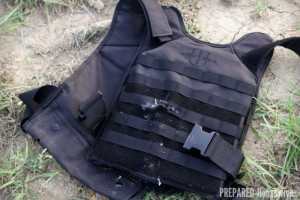 Bullet proof vests dramatically increase your chances of surviving an attack involving a firearm, and yet they can only defend against certain ammunition. Similarly, they can never completely guarantee protection, and are often referred to as bullet resistant or even simply ‘Kevlar Vests’. Bullet proof vests are tested and graded according to international standards set by the US National Institute of Justice. These protection levels outline exactly what body armor can protect you against. Below are some of the most common, popular, and famous firearms, and an explanation of what is needed to protect against each.
Bullet proof vests dramatically increase your chances of surviving an attack involving a firearm, and yet they can only defend against certain ammunition. Similarly, they can never completely guarantee protection, and are often referred to as bullet resistant or even simply ‘Kevlar Vests’. Bullet proof vests are tested and graded according to international standards set by the US National Institute of Justice. These protection levels outline exactly what body armor can protect you against. Below are some of the most common, popular, and famous firearms, and an explanation of what is needed to protect against each.
The Most Popular Firearms vs. The Kevlar Vest
The Colt Python was first made in 1955 by Colt, and is often referred to as a ‘combat magnum’. Colt stopped production in 1999, and the final release of the Python was in 2005. This revolver was originally favored by law enforcement, with different variants used for different roles. However, the modern need for semi-automatic pistols meant it fell out of favor. To protect against the Colt Python you will need a Level II bullet proof vest.
The Smith & Wesson 686 double action revolver was first introduced in 1980, and gained fame and popularity thanks to its adoption by the US Navy Special Operations. This revolver is popular for waterborne missions in particular because of its durability in the face of exposure to the elements, and it is easy to maintain compared to similar weapons. The Smith & Wesson 686 is also famed for its use by Luxembourg’s Grand Ducal Police. Protection against this weapon requires a vest at Level II.
The SIG Sauer P226 follows the same basic design of the SIG Sauer P220, but was developed to use higher capacity staggered-column magazines. It was originally conceived as a replacement to the M1911A1 used by the US Army, but it was eventually beaten by the Beretta 92F. However, the SIG Sauer P226 still gained fame thanks to its adoption by the Navy SEALs. A bullet proof vest at Level II is needed to protect against this weapon.
Ruger 10/22
 The Ruger 10/22 is a semi-automatic rimfire rifle, designed as an ‘adult gun’ that could nevertheless provide easy handling. This, coupled with low recoil, made the Ruger 10/22 popular with young and inexperienced shooters, as well as being popular among small game hunters. It is also known for its compatibility with modifications, which are relatively easy to create and equip compared to other rifles. Protection from this rifle would require a Level II bullet proof vest.
The Ruger 10/22 is a semi-automatic rimfire rifle, designed as an ‘adult gun’ that could nevertheless provide easy handling. This, coupled with low recoil, made the Ruger 10/22 popular with young and inexperienced shooters, as well as being popular among small game hunters. It is also known for its compatibility with modifications, which are relatively easy to create and equip compared to other rifles. Protection from this rifle would require a Level II bullet proof vest.
FN SCAR
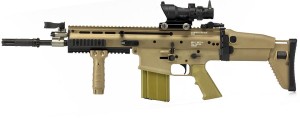 Constructed to be extremely modular, the FN SCAR became incredibly popular thanks to its use by the US Military. It is available in two common variants; the SCAR-L for ‘light’ ammo (5.56x45mm NATO) and the SCAR-H for ‘heavy’ ammo (7.62x51mm NATO). The first rifles were issued in April 2009, and given to a battalion of the US 75th Ranger Regiment. However, US Special Ops Command would later drop the SCAR-L in favor of the SCAR-H, and plan on adopting conversion kits for the MK17 SCAR-H to enable their use of 5.56mm ammo. As of early 2015 the FN SCAR in various types was used by special ops/police in over 20 countries. The FN SCAR-L requires a Level III bullet proof vest, though only a Level IV vest can protect against the SCAR-H.
Constructed to be extremely modular, the FN SCAR became incredibly popular thanks to its use by the US Military. It is available in two common variants; the SCAR-L for ‘light’ ammo (5.56x45mm NATO) and the SCAR-H for ‘heavy’ ammo (7.62x51mm NATO). The first rifles were issued in April 2009, and given to a battalion of the US 75th Ranger Regiment. However, US Special Ops Command would later drop the SCAR-L in favor of the SCAR-H, and plan on adopting conversion kits for the MK17 SCAR-H to enable their use of 5.56mm ammo. As of early 2015 the FN SCAR in various types was used by special ops/police in over 20 countries. The FN SCAR-L requires a Level III bullet proof vest, though only a Level IV vest can protect against the SCAR-H.
HK416
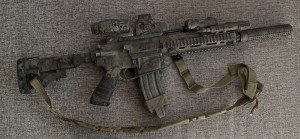 Named for the makers (Heckler & Koch), the HK416 is based on the AR-15 platform and was designed as an improvement on the M4 Carbine for the US army. This Automatic was made famous as the rifle used by the Navy Seals to kill Osama Bin Laden. The HK416 was adopted as the standard rifle of the Norwegian Armed Forces and is in official use by countries all over the world. This famous weapon uses a gas system which reduces malfunction and increases the longevity of its parts. A Level III bullet proof vest is necessary to protect against this weapon.
Named for the makers (Heckler & Koch), the HK416 is based on the AR-15 platform and was designed as an improvement on the M4 Carbine for the US army. This Automatic was made famous as the rifle used by the Navy Seals to kill Osama Bin Laden. The HK416 was adopted as the standard rifle of the Norwegian Armed Forces and is in official use by countries all over the world. This famous weapon uses a gas system which reduces malfunction and increases the longevity of its parts. A Level III bullet proof vest is necessary to protect against this weapon.
AK-47
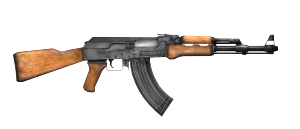 Designed in 1945, finished in 1946, and adopted by the Soviet Army in 1948. In 1949 it became the official weapon of the Soviet Armed Forces. The AK-47 is one of the most famous weapons in the world, and there is little that can be said about it that hasn’t already been said. The AK-47 is renowned for its reliability, accessibility, and its low production costs. The AK-47 is so popular that they make up approximately 15% of all firearms in the world. Protection against an AK-47 requires the highest level of protection at Level IV.
Designed in 1945, finished in 1946, and adopted by the Soviet Army in 1948. In 1949 it became the official weapon of the Soviet Armed Forces. The AK-47 is one of the most famous weapons in the world, and there is little that can be said about it that hasn’t already been said. The AK-47 is renowned for its reliability, accessibility, and its low production costs. The AK-47 is so popular that they make up approximately 15% of all firearms in the world. Protection against an AK-47 requires the highest level of protection at Level IV.
M16
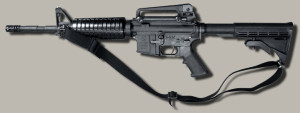 A US military adaptation of the AR-15, the M16 is another incredibly famous and popular rifle. The M16 was most famously used in Vietnam from 1963, and in 1969 the M16A1 replaced the M14 rifle to become the US military’s standard service rifle. In 1983, the USMC adopted it as their official weapon, and three years later the US army did the same. The M16 is the most produced firearm of its 5.56mm caliber, and total worldwide production of the rifle is approximately 8 million. The M16 was originally designed as part of an effort to replace the M1 Garand and other similar weapons, but also as a direct US competitor to the AK-47. Protecting against this famous weapon will require a vest at Level III.
A US military adaptation of the AR-15, the M16 is another incredibly famous and popular rifle. The M16 was most famously used in Vietnam from 1963, and in 1969 the M16A1 replaced the M14 rifle to become the US military’s standard service rifle. In 1983, the USMC adopted it as their official weapon, and three years later the US army did the same. The M16 is the most produced firearm of its 5.56mm caliber, and total worldwide production of the rifle is approximately 8 million. The M16 was originally designed as part of an effort to replace the M1 Garand and other similar weapons, but also as a direct US competitor to the AK-47. Protecting against this famous weapon will require a vest at Level III.

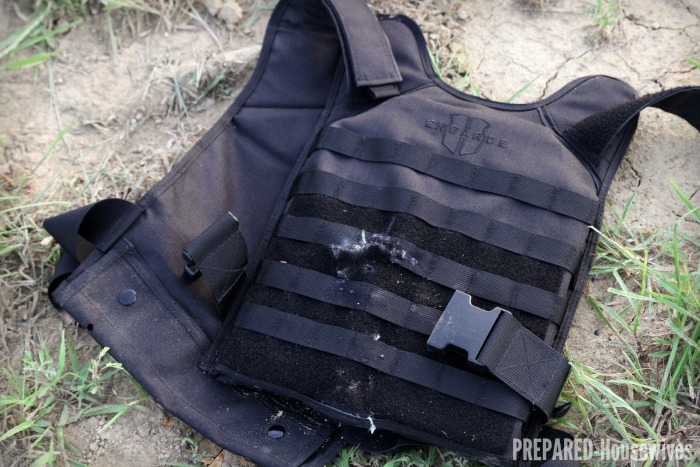
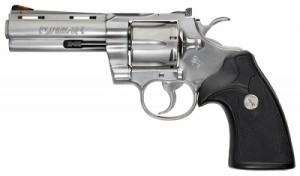
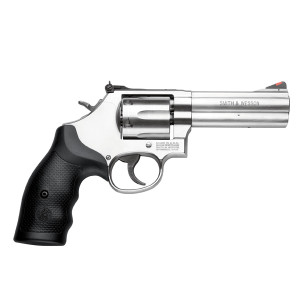
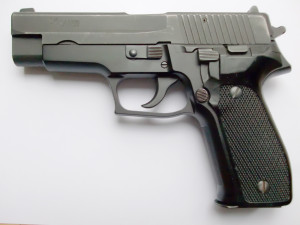
3 replies on “Guns vs. Armor; What Level of Kevlar Vest Matches up Against the Most Popular Firearms?”
It’s interesting to learn about gun on an educational level.
Concerning 12 ga. shotgun that jams up. Do you have a pump shotgun? Use only high brass shells . That should take care of that problem. I had the same problem and just changing to high brass fixed it. You don’t need to have a situation where someone is breaking into your dwelling and your pump shotgun jams up on you. Many stores don’t sell high brass shells anymore! You can go online looking for them instead. Vote with your feet or finger as it was.
Kevlar has a tensile strength of about 8 times more than that of a steel wire. Tensile strength is basically the resistance offered by a material against a force to prevent elongation. It is also relatively light in weight for a material that is so strong. It has a very high resistance to heat (decomposes at around 450?), and unlike most other plastics, it does not melt or even expand upon heating. It is also highly resistant to cold and does not become brittle at very low temperatures. It is highly resistant to abrasion of any kind.